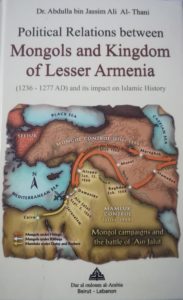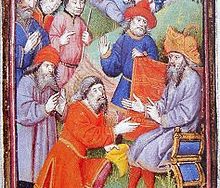
Political Relations between Mongols and Kingdom of Lesser Armenia (1236-1277AD) and its impact on Islamic History (published in Beirut, 2020), Dr. Abdulla bin Jassim Ali Al-Thani
In his book Political Relations between Mongols and Kingdom of Lesser Armenia (1236-1277AD) and its impact on Islamic History (published in Beirut, 2020), Dr. Abdulla bin Jassim Ali Al-Thani writes about the regional order in the Near East during the 13th century and the impact of multipolarity on diplomacy and military alliances. While the author takes an Islamocentric and pro-Arab (sometimes anti-Armenian) stance, he analyzes the root factors that pushed for the Armenian-Mongolian diplomatic and military alliance, their relationship with the Crusaders and the Sultanate of Rum (Seljuks), their containment strategy against the Mameluks and the strategic mistakes of the Armenians, which ultimately led to the destruction of the Cilician kingdom at the hands of the Mameluks.
Relations between Armenians and Mongols are understudied. Traditionally, Armenian historians have highlighted the dark side of this history, such as the barbaric attitude of the Mongol Khans and the suffering of Western Armenians under the Mongol yoke. However, the Armenian Kingdom of Cilicia chose the diplomatic way, allying with the Mongols against their common threats, namely, the regional Arab and Turkish powers. This is an unlikely example of a Christian kingdom reaching out to a distant, invasive, as-of-yet-pagan force in order to face the Muslim powers of the region – geopolitics par excellence. This relation was based on pure realist calculations and not on fate or ideological beliefs.
The Factors Behind the Armenian-Mongol Rapprochement
Among the kings of Armenian Cilicia, Hethum I (founder of the Hethumian dynasty) reigned the longest, ruling from 1226 to 1270. Due to local and regional calculations, King Hethum I’s ultimately threw himself into the arms of the Mongols. According to Dr. Abdulla bin Jassim Ali Al-Thani, Hethum I wanted to consolidate his kingdom’s position in international trade, and his main regional competitors were the Mameluks in the south. The king also foresaw the end of the crusaders, believing that they were incapable of facing the Muslims. He writes, “At that time, the Armenian king[‘s] policy was to preserve his crown and his kingdom from being lost even if he will become a follower of the devil of that age embodied by the Mongolians.” Marco Polo, the famous Venetian merchant and explorer, mentioned in his writings that the Armenian kingdom was “an easy prey between the Tatar’s lion, and the Mameluk’s tiger and the Turkish’s wolf, and the Sea Pirate’s Snake.” The Armenian kingdom needed the security of one of the great powers to survive. The Crusaders were not going to aid the Armenians, unless the Armenian Kingdom converted to Catholicism, and the Mameluks were the main economic competitors of the Armenians. Therefore, the least non-conditional or balanced partnership was with the Mongols.
In 1247, Hethum sent his brother Sembat to the Mongol court in Karakorum, the Mongol capital. The diplomatic achievements of this mission were minimal, even though Sembat returned married to a Mongol princess, as an expression of solidarity between the two people. According to the initial agreement, Cilician Armenians were given the right to enjoy complete independence in conducting their internal affairs. The Mongol Khan also promised to exempt all Christian churches and monasteries subjected to Mongolian sovereignty from taxes. This step was crucial for the Armenians, as they mobilized other Christians sects such as the Georgians and Nestorians to fight under the Armenian leadership.
The Armenian-Mongol Alliance
However, King Hethum I was not satisfied with his brother’s deal, and in 1254, he undertook the mission himself and traveled to meet the Mongol Khan. Hethum I thus was the very first Christian ruler to visit the Mongols.
The Armenian King presented the following proposal to the Mongol Khan:
- Peace and fraternal relationship should be established between the Mongols and Armenians.
- All Christian priests and monks under Mongol rule should be released from captivity and church property must be returned to the church.
- The Mongolian people and their Great Khan should be baptized and converted to Christianity.
- The Mongol Khan should provide advice and military assistance to recover the Holy Land from the grips of Muslims and give it back to Christians.
- Christians and Mongols must unite to put an end to the Abbasid Caliphate established in Baghdad.
- Mongol Khans must provide the necessary military and logistical assistance to the Armenian kings to expand their borders.
- All the Armenian lands which were recently occupied by the Muslims should be restored back to the Armenian kingdom.
Notably, the Mongol Khan agreed to all the terms, and he and his court members were baptized with water from the Armenian church. No force or coercion was used to baptize the Mongols. In return, the Armenian Kingdom of Cilicia along with two other semi-independent areas in historical Armenia allied with the Mongol Empire in their campaigns against the Muslim presence in the region. Moreover, unlike other Christian kings, King Hethum I was treated well by the Mongol Khan and was appointed as a counselor regarding matters in the Near East.
This alliance, as the author writes, was an alliance based on the self-interest of each party; however, it was mutually beneficial for both sides. Armenians, assisted by the Mongols, expanded east and south, recovered their castles and controlled trade routes, while the Mongols wanted to put an end to the bipolar regional order, crush their rivals the Mameluks and establish a unipolar regional system in the region. Moreover, the Armenian king was aware of the international changes and the emergence of a new force that flipped the balance of power head over heels. Hethum I realized how dangerous the Mameluk Sultanate was for the newly established Armenian kingdom; hence, he believed that by conducting a strategic pact, the Mongol force could protect his kingdom from the Islamic danger. Hethum also tried to transform the Armenian-Mongol alliance into a tripartite alliance that included the crusaders, yet, this was not fully achieved.
On February 15, 1258, the Mongols, with the help of Armenians and Seljuks, laid the Siege of Baghdad. The role of the Armenians was crucial in overthrowing the Abbasid Caliphate in Baghdad. In the following years, Armenians fought under the Mongol banner and annexed Antioch to secure the transport links between Egypt, Damascus and Aleppo. By 1260, Aleppo and Damascus were already under Armenian-Mongol control. Cilicia recovered its kingdom and fortresses and tried to expand towards Cappadocia and Levant where the most significant trade routes were located. The Armenian king hoped to win the trust of Christians and secure trade prosperity and welfare for his people. However, the Crusaders, feeling the strong connection between the Mongols and the Orthodox Christians and afraid of falling under the Eastern Churches’ mercy, were unwilling to join the alliance.
Nevertheless, this victory was short-lived, as the defeat in the battle of Ain Jallout (September 1260) dealt a blow to the Mongolian empire that marked the beginning of its end. The Mameluks, taking advantage of the anarchy in the ranks of the Mongols and the power vacuum, engaged in a counteroffensive and retook land including the cities of Damascus and Aleppo. Despite the defeat on the ground, the Armenians never revised their strategy, insisting that the Mongols organize a new invasion on the Levant. Yet this position further antagonized the Mameluk Sultanate of Egypt.
Assessment, Diplomatic Miscalculations and the Fall of the Armenian Kingdom of Cilicia
The Mongol expansion into the Near East was halted by an alliance between the Franks in Acre and the Egyptian Mameluks at the pivotal Battle of Ain Jalut, in which 500 knights from Cilicia participated on the side of the Mongols. The Armenian calls for a wider Christian-Mongol alliance against Mameluks, advanced by Hethum the Historian (not to be confused with King Hethum I), were ignored by the Latin powers in the Levant, leading to the demise of the European Crusader principalities and the imminent failure of the Crusades as a whole.
From the Mameluk perspective, the Armenians and Crusaders were the main reasons for bringing the Mongols to the Levant and reaching Egypt. But destroying the Armenian-Mongol coalition was the main reason the Mameluks struck the Cilician kingdom, which collapsed completely in 1375 A.D. The second reason was economic, since the Armenian kingdom controlled the trade routes and imposed an economic embargo on the commercial activities of the Mameluks. The Mameluks eyed the Armenian Ayas harbor, which competed with the port of Alexandria and generated great amounts of money due to its location along the cheapest trade route between Eastern Asia and Western Europe.
After crushing the Armenian-Mongolian-Seljuk army, the Mameluks killed several Armenian princes, captured Hethum’s son Levon and sabotaged the capital of Cilicia, Sis. Their Sultan demanded that the Armenian kingdom become a subject of the Mameluk Sultanate by pledging loyalty to the latter, paying an annual tax and opening trade markets between the two kingdoms. However, Hethum rejected this offer out of fear of his Mongolian allies. As a result, Mameluks plundered and burned the Armenian kingdom for 20 days. The Armenian king was forced to abdicate in 1270 in favor of his son Levon since neither the Pope and the Europeans nor the Byzantine Empire granted him assistance. He lived out the rest of his life in a monastery, as a monk.
Believing that the Mongols would not offer salvation, Armenians tried to consolidate their relations with the Franks. Due to the policy of inter-marriage between the royal families of Cyprus and Cilician Armenia since 1254, the French Lusignan dynasty had been established in Cilicia. However, this brought instability in the Armenian kingdom as the pro-Latin Lusignans tried to impose Catholicism and the European way of life. The Armenian leadership largely accepted this, but the peasantry opposed the changes. Eventually, this led the way to civil strife. In April of 1375, taking advantage of the internal Armenian divisions, the Mameluks launched their decisive strike. Sis fell once again and the last Armenian King, Levon V, was granted safe passage and died in exile in Paris in 1393.
What can we learn from this period of our history? Many consider Hethum I one of the most brilliant political minds of the Middle Ages. He was the maker of political foundations based on containing the Mameluks and cooperating with the Mongols, Crusaders and Seljuks. However, the defeat of his kingdom destroyed his morale, and he gave up his throne to this son. Hethum realized he could not rely on the West, and his policy of aligning with the Mongols emerged from the circumstances and variants to the balance of power during the 13th century. He strived to establish a Mongol-European alliance yet ultimately failed to do so. After the Armenian defeat at the hands of the Mameluks, the Armenians realized that the balance of power was not in their favor; however, they failed to revise their strategy, and instead of establishing peace with the Mameluks, they put their hopes on the Crusaders in Europe.
The Armenian King didn’t consider the internal division among the Mongols, as some of the Mongol Khans, who had converted to Islam, openly supported the Mameluks. Meanwhile, the Crusaders not only stayed neutral during the Mameluk-Mongol war but also contributed to the defeat of the Mongols when they allowed the Mameluks to cross through their territory rather than block their way. If the Armenians stayed away from the Mongol-Mameluk war, they would have avoided the destruction of their kingdom, but would have faced the Mongol army.
Diplomacy is about long-term strategy. King Hethum I, despite his flexible and realist approach towards the Mongols, thought of short-term victories and did not revise his strategy when he realized the Mongols were being overrun and weakened. Moreover, he put a lot of hope on the Christian West, which was far away from his Kingdom, while the Mameluks were at its gates. This important period of our history, with its brilliant diplomatic lessons and tragic failure, should teach us about statecraft in international affairs. Alliances always come at great risk. Sometimes they are a necessity, especially given the geopolitical situation of our nation throughout centuries. However, flexibility driven by national interest is motivated by political and national will. This short period of our Cilician history can teach important lessons to our diplomats and policymakers. I am not a historian to judge a certain historical era of our nation; however, this short period of our history shows how great kings can bring prosperity and doom to a kingdom. Ultimately, diplomacy is an art, and an artist is influenced by his/her surroundings.
The article was originally published in the Armenian Weekly, 5/10/2021.







